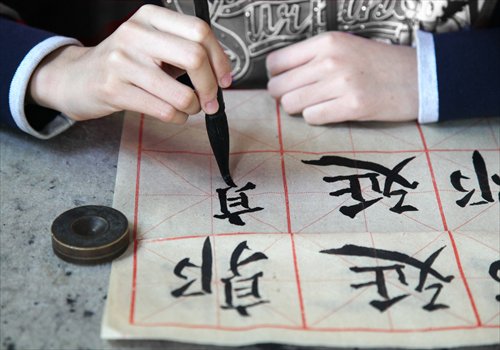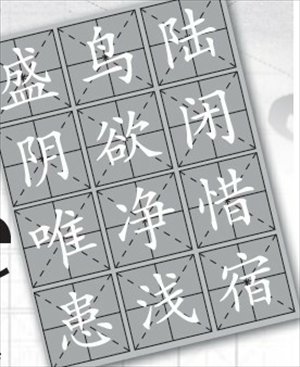Linked by language

Photo: CFP

Several of the chosen 800 Chinese characters
China, Japan, and the Koreas - these East Asian countries not only share general physical features like black hair and yellow skin tone, they also share unique languages using writing systems vastly different from Western alphabets.
When one compares the written languages of Chinese, Japanese and Korean, it is quickly seen that some of the characters used look very much alike, and in some cases, the characters are exactly the same. The three languages are deeply connected. Putting aside the political and historical elements, new steps have been taken recently to bring the connection to a new era.
During the eighth session of the Northeast Asia Trilateral Forum, held in Hokkaido in Japan in July, a draft chart was released showing 800 commonly seen Chinese characters that are shared and used by these three languages, and a final chart will be formally announced in 2014, according to Xinhua.
Based on 2,500 commonly used Chinese characters in China, 1,006 in Japan and 900 in South Korea, scholars attending the forum chose 800 characters shared by the three countries. According to the evaluation of the forum, it will lay a foundation for youngsters from the three countries to understand each other's languages if they can master these 800 characters.
With the aim of seeking common ground and promoting exchanges, the trilateral forum was co-sponsored by China's Xinhua News Agency, Japan's Nikkei Inc and South Korea's JoongAng llbo. Since the first forum in 2006, the annual meeting has been held alternately in the three countries. The draft chart of 800 Chinese characters is one of the main achievements of this year's forum.
Similarities and differences
Languages of these three countries still have much in common. Those who travel to Japan find that although they can't understand a bit of Japanese when listening to it, they sometimes can guess the meaning when reading it, because some characters have retained their original Chinese meaning. However, with some characters the meaning has changed substantially.
Zhu Guirong, an associate professor of Japanese education at Beijing Foreign Studies University, used an example to explain: The Chinese character niang (娘) means mother in Chinese, but in Japan it means daughter. Another two characters shou zhi (手纸), meaning toilet tissue in Chinese, means letter in Japanese. One can imagine how embarrassing it could be to confuse the two.
"Those characters with the same meaning, or those with the totally different meaning might be easier for Chinese students to learn. But those that are partially the same and partially different are the hardest to deal with," said Zhu.
Another fact was mentioned by Lim So-yeon, a Korean girl who has been living in China for over 10 years. Xian sheng (先生) is an ancient expression used when Chinese students addressed their teacher, however, it is not used often. Koreans, on the other hand, still use it and write it in traditional Chinese characters.
Zhu mentioned her discussion with Japanese and South Korean scholars when she visited those two countries. "Why emphasize the differences? Why don't we pay more attention to the similarities," she asked when discussing the translation of the expressions that mean cross-culture in two languages.
The Chinese expression is kua wen hua (跨文化), which emphasizes linking different cultures, whereas the Japanese expression is yi wen hua (异文化) and emphasizes the differences between cultures. The appeal of emphasizing links between cultures was echoed during the discussion.
A history lesson
Tracing back to the 1st century, a few vestiges of the origins of these languages can be found. Although without any recorded history and exact dates, some linguists believe that it was at the end of the Han Dynasty (206BC-AD220) that the ancient Chinese characters were substantially introduced to the Korean Peninsula.
According to an academic thesis called The Spread and Learning of Chinese Characters in South Korea and Japan by Luo Weidong, since AD375, visits by envoys from the two countries and the introduction of Confucian classics helped to spread Chinese characters. "At that time, the culture of Han was admired and treated as the excellent eastern Asian culture. Koreans used Han characters to record their history, to create their literature and to record their own language."
In terms of Japan, most believe that the Korean Peninsula is one of the channels that transported ancient Chinese characters there. But envoys from ancient Japan also came to China to learn Han culture, and they contributed to the spread of the writing system as well, according to the thesis.
At that time, Japanese and Korean languages were not attributed to any language system, and they were called "agglutinative languages." The introducing of Chinese characters helped to settle their own writing systems.
"The different locations and different inheritance led to different evolutions over the long period," Zhu told the Global Times.
Fever of learning Chinese
Many foreign students can be seen in Beijing now, and the numbers coming from South Korea and Japan are on the rise.
Lim started to learn Chinese when she was still a student in South Korea. She came to China around 2001 and went to Tsinghua University to study Chinese as her major after a few years. She said that sharing some Chinese characters is helpful. Because in their own language there are many words that contain multiple meanings, and sometimes it's confusing. But using some Chinese characters helps to distinguish the different meaning in some instances.
Zhu also saw the enthusiasm for learning Chinese among Japanese and Korean students. "Students are showing a high interest in learning Chinese. I think they noticed the frequent connections between these countries, no matter in economics or in culture."
As Ji Baocheng, editor of the chart and former president of Renmin University of China, said at the forum, "The chart of 800 characters is the symbol of the connections between China, Japan and South Korea and is a key link for cultural cooperation for us."